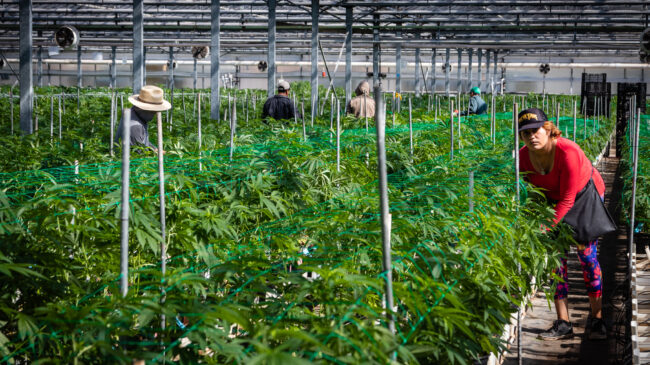This post is an excerpt from the recommendations section of the policy study: “The impact of California cannabis taxes on participation within the legal market.”
The analysis presented in Part 5 of this report makes clear that California’s adult-use cannabis market should be expected to grow more quickly in response to a reduction in tax rates.
Part 2 shows that California’s marijuana tax rates are high compared to other states with mature legal marijuana markets and that local assessments quickly compound with state assessments such that the per-pound equivalent of cannabis taxes in California can range as high as $1,441 per pound.
Parts 3 and 4 of the report demonstrate that retail prices in California are higher than in other states with established cannabis markets and that consumer spending per capita on legal cannabis products is significantly lower. Lower per-capita spending in California is not fully explained by differences in cannabis usage rates, implying through the data that Californians spend roughly twice as much on illegal cannabis products as on legal ones.
Tax costs are a significant component of retail marijuana prices in California and this analysis shows that a reduction in taxes can make legal products more price-competitive with illegal products and lure more consumers into the regulated market. This overall market growth will quickly displace the lost revenue resulting from a reduction in tax rates.
Moreover, policymakers may wish to consider a reduction in California’s cannabis taxes for reasons beyond economic or fiscal impacts. High taxes on legal products, combined with a paucity of legal retailers in many regions of the state, encourage consumers and producers to frequent the illegal market. Transactions on the illegal market are unregulated and may be a threat to public safety. Illegal products are untested and may be contaminated. Participants in illegal markets have no legal recourse to peaceably resolve disputes and sometimes resort to violence. International drug cartels may become prominent suppliers of illegal products in extraordinarily high-tax areas or those without legal retailers.
Tax costs are a significant component of retail prices and this analysis shows that a reduction in cannabis taxes can make legal marijuana products more price-competitive with illegal products and attract more consumers to the regulated market.
For all these reasons, California lawmakers should consider major changes to the state’s cannabis taxes.
- Repeal or suspend the cultivation tax. As Reason Foundation has noted previously, wholesale cannabis taxes are hidden from the ultimate consumer, and difficult to administer and audit and pyramid up the supply chain. This analysis makes additionally clear that repealing the cultivation tax will result in faster growth of the legal market and will quickly result in more total tax revenue than the state receives currently. If the cultivation tax is eliminated and no other changes are made, the total monthly state revenue from taxes on cannabis transactions by December 2024 will be more than double their March 2022 level.
- Reduce retail excise taxes. Part 3 compared California’s cannabis market performance to two states—Colorado and Oregon—that levy retail excise taxes but exempt cannabis sales from general sales taxes. California applies both taxes to retail transactions on cannabis, raising its effective tax rate substantially above competing markets. Policymakers needn’t fully eliminate the retail excise tax, but reducing its rate combined with eliminating the cultivation tax could lead to much faster growth of the legal market and displacement of the illegal market. Under Scenario 3, a reduction of the excise tax from 15% to 10% would still yield $119 million in monthly state tax revenue from cannabis sales by December 2024, which is nearly double its current level.
- Explore methods to induce greater participation by local governments. Proposition 64 and the Medicinal and Adult-Use Cannabis Regulation and Safety Act (MAUCRSA) allow local governments to ban cannabis enterprises within their jurisdictions, with a shocking number of California’s local governments doing so. Part 3 shows more than half of the state’s legal retailers are concentrated in just 18 jurisdictions. Meanwhile, massive cannabis deserts exist across the state in which consumers have no access to a legal retailer within a reasonable distance of their homes. Without legal alternatives, these consumers are likely to patronize illegal retailers.
Removing the authorities granted to local governments under current law would be a fundamental change to the state’s cannabis market, but several states allow local governments only to reasonably regulate the times and manner of cannabis enterprise operations without imposing outright bans. However, lawmakers needn’t go that far, as alternative approaches might help induce more local governments to participate. For example, the state could direct a portion of its cannabis tax revenues toward a revenue-sharing pool in which local governments can participate proportionally along with the sales volume that occurs within their jurisdictions.
At the same time, however, state lawmakers should seek to limit the additional layers of taxation assessed by local governments because these taxes compound to make legal products uncompetitive on a price basis with illegal products. In other words, the state may be able to creatively displace local government tax revenues such that a reduction in state taxes is not offset by further increases in local tax rates.
Full Policy Study: The Impact of California Cannabis Taxes on Participation Within the Legal Market

